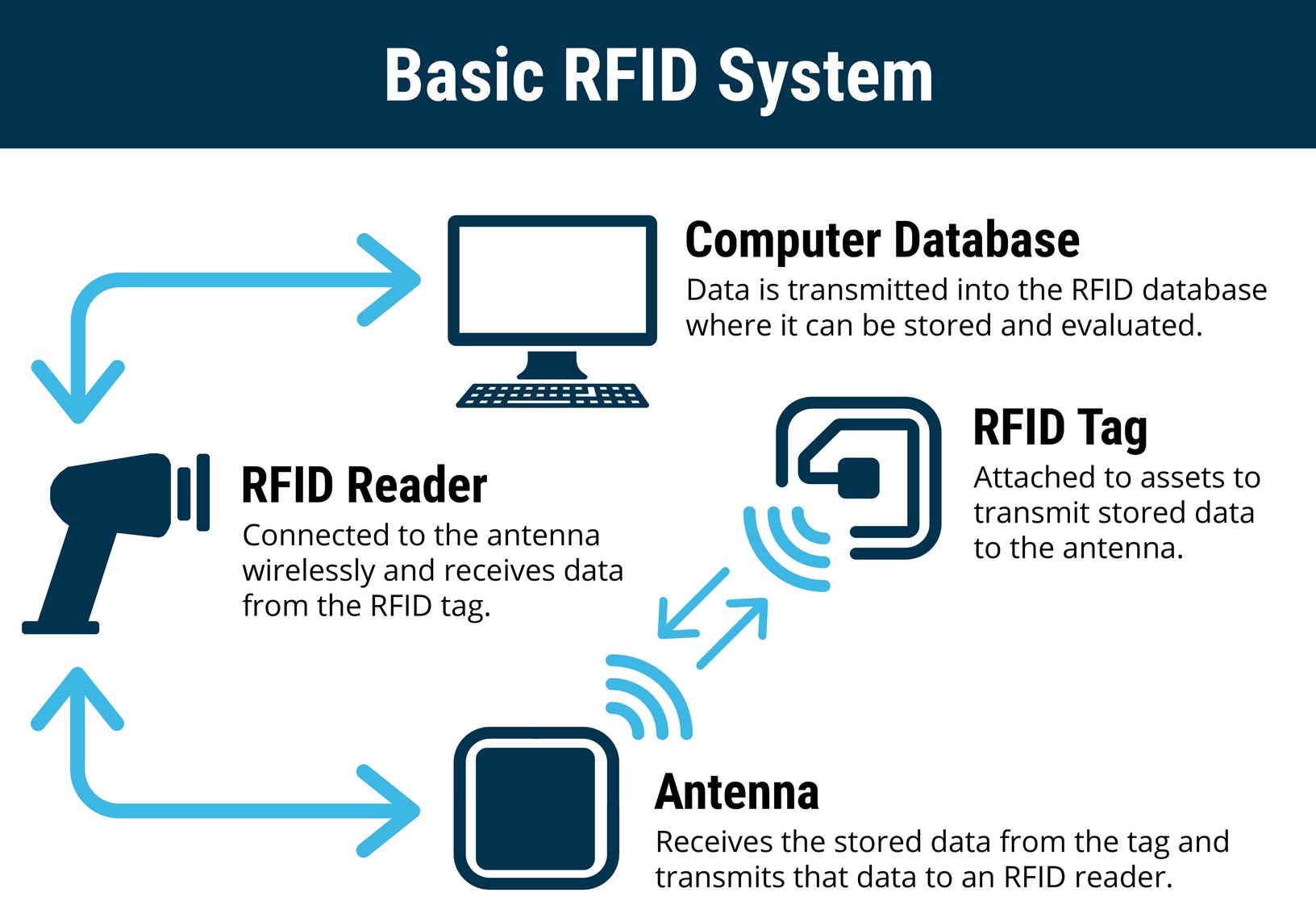What is RFID (Radio-Frequency Identification) Technology?
Radio Frequency Identification or RFID is a specific type of radio technology that uses radio waves to identify tags attached to an object and thus identify the object. RFID technology is an essential tool for logistical applications and is being used to optimise supply chains and production processes across different industries.
The key to an RFID strategy is to align your use of the technology with your company's goals, e.g., reduce production costs, better customer relationships, optimising operations, and more. RFID technology can help you reach your goals.
Making manufacturing more efficient and productive is a shared goal throughout all industries, not to mention electronics. RFID technology has been designed for this purpose. Radio frequency identification can be used to track products through the product lifecycle, data collection to analyze logistics, and production flow to enhance the manufacturing process.
In this article, we discuss what makes up an RFID system, the advantages and disadvantages of the technology, its usage, and the overall market outlook.
Chapters
Chapter 1
What is RFID (Radio Frequency Identification) Technology?
Radio Frequency Identification or RFID is a specific type of radio technology that uses radio waves to identify tags attached to an object and thus identify the object. The tag contains a transceiver chip which is triggered by the electromagnetic wave from the RFID reader and transmits an identification number back to the reader. The identification number is then used for the inventory of the objects with tags. Tags can be passive or active. Passive tags are only powered by the incident electromagnetic wave from the reader and thus have a shorter operating range. Active tags are powered by a battery and can have greater range, up to hundreds of meters.
With the use of wireless technology, RFID tags do not need a direct line-of-sight to the RFID reader, which brings some significant advantages compared to the barcode scanners widely used in the industry today.
The RFID tag can be embedded or hidden in the object, and several tags can be identified at the same time by a single reader.
A barcode scanner has to ‘see’ a barcode to gather data.
RFID is used in many applications and industries, including pharma, retail, agriculture and medical care, as well as tracking vehicles, pets, and livestock. For example, an object with an embedded RFID tag that is moving through a production line or a warehouse equipped with RFID readers, can be scanned at different production stations and thus its progress can be automatically tracked.
The technology has continued to improve over the years, and the cost of implementing and using an RFID system has continued to decrease, making RFID a cost-effective and efficient alternative to conventional optical scanning. Standard specifications have been developed for RFID technology, addressing security and privacy concerns. Such standards use on-chip cryptography methods for untraceability and tag and reader authentication using digital signature data.
RFID Technology: How Does it Work?

What are the Main Components of RFID Technology?
Tags
RFID tags are what stores and transmits the data that needs to be deciphered. The tags can be attached to assets to send data to the antenna. The microchip embedded in the tag is what stores the tag's ID and programmable data related to the asset. This stored data is then transferred to the reader through antennas.
Antennas
Antennas are necessary elements in an RFID system because they transmit the RFID tag’s data to the reader. Without some type of RFID antenna, whether integrated or standalone, the RFID reader cannot correctly send and receive signals to RFID tags.
Readers
RFID readers are connected to the antenna and receive data from the RFID tag. The reader is what receives and converts the radio waves into digital data on a computer database.
There are two types of readers. There are Fixed Readers and Mobile Readers. Fixed readers are typically mounted to walls or other objects and stay in one location to read data stored in a tag. Mobile readers can be installed or carried anywhere it is needed.
Computer Database
The RFID system requires a computer database to process data stored in tags. This software can program tags, manage devices and data, remote monitoring and hardware configuration.
Chapter 2
RFID Tags: Categories, Frequencies, and Applications
RFID transmits data to a reader through different frequencies of electromagnetic fields.
RFID tags are categorised according to the frequency at which they are designed to operate. There are three major frequency ranges that RFID tags operate.
- Low-Frequency (LF) Tags
- High-Frequency (HF) Tags
- Ultra-High Frequency (UHF) Tags - passive and active
1. Low-Frequency Tags (LF)
- The primary frequency range of 125kHz – 134kHz
- Can read a span of a few inches
- Lowest data transfer rate among all the RFID frequencies
- Store a small amount of data
LF Applications – Animal Tracking, Access Control, Car Key-Fob, Asset Tracking, and Healthcare
2. High-Frequency Tags (HF) - Most widely used around the world
- The primary frequency range of 13.56MHz
- Read range: 30 cm
- The capability of reading multiple tags simultaneously
- Can store up to 4k of data
- Easily read while attached to objects containing water, tissues, metal, wood, and liquids.
HF Applications – Library Books, Personal ID Cards, Airline Baggage, and Credit Cards
3. Ultra-High Frequency Tags (UHF)
There are two types of tags that use different frequencies under UHF RFID.
UHF Passive Tags - use energy from the RFID reader
- The primary frequency range: 860MHz – 960MHz
- Read Range: 25 meters
- High data transmission rate
- Wide variety of tag sizes
UHF Passive Tag Applications – Supply Chain Tracking, Manufacturing, Pharmaceuticals and Electronic Tolling
UHF Active Tags - battery operated
- The primary frequency range: 433MHz
- Read Range: 30 - 100+ meters
- Large memory capacity
- High data transfer rate
UHF Active Tag Applications – Vehicle Tracking, Auto Manufacturing, and Construction
Chapter 3
Pros and Cons of RFID
RFID can be used to reduce production costs and optimise operations.
However,
If you are considering RFID technology to streamline production, track, and analyze data collection and more, there are pros and cons to weigh.

The most significant benefit of using RFID technology over other methods in manufacturing is that it does not need a line of sight to be scanned or identified. This gives more flexibility to the production and supply chain process.
The biggest drawback to consider is if the technology is vulnerable to software attacks.
Resources:
Chapter 4
RFID Technology Applications in Different Industries
RFID technology is already a part of everyday life, and most people are not even aware they are interacting with this technology. For example, when you unlock your hotel room door by waving your key card, or have a microchip implanted in your pet, you are using RFID technology. The application of RFID technology across industries continues to evolve, rendering RFID elements across major world industries.
Aerospace & Defence
Over the past decade, Aerospace and Defence manufacturers have focused on making specific process areas RFID-enabled. Airframers leverage RFID technologies to keep tabs on thousands of airplane parts and strengthen their supply chain. Automating and error-proofing even a single business process can deliver a significant return on investment, allowing you to build value quickly as you improve operations.
This is why today's leading Aerospace and Defence companies have turned to RFID technologies for key process areas like Supply Chain, Manufacturing and Maintenance & Repair.

Medical
New RFID efficiencies and care touch all aspects of the healthcare industry. Whether it be superior management of operations and systems or more precise personnel and safety processes. RFID is helping in the reduction of costs in healthcare.
"The reason why healthcare costs are so high is hospitals keep buying things they already have and waste money." Mark Roberti, the founder and editor of the RFID journal
The healthcare industry is undergoing an RFID-assisted revolution, one that is helping to save lives.

Industrial Internet of Things (IIoT)
The rate at which businesses are connecting through the Internet of Things technologies is rapidly increasing. Industrial IoT helps manufacturing companies maximise their productivity. Through the product lifecycle, the software can be used to organise data, analysis, and documentation. Readers can identify, track, and monitor in real-time and share industry-wide.
5G will play a role in providing exceptional voice and data communications. Supply chain management will benefit from data being transferred faster in real-time. 5G signals will be more reliable than older types of cell signals.
Various devices can share information to gain better data insights, which will enable data-driven decisions. For example, IoT solutions can manage energy, security, and lighting in a home or workplace.

Chapter 5
Future RFID Technology Market Outlook
"Current trends indicate that the market will grow fast in the next 8-10 years. With 6.9 billion having been sold worldwide in 2014, the value of the market is anticipated to increase by a factor of ten during 2017-2025." [source]
Today more and more industries are looking at RFID technology as an alternative identification system for challenging and complex environments.
Eighteen months ago, Identiv announced its creation of a Tamper-Proof RFID label. The label’s data carrier, known as an inlay, erases all information embedded once torn from its adhered surface. This technology would prevent the spread of company data to unwanted parties, which usually is a security issue to be considered with RFID technology.
The printed sensors integration onto the RFID smart labels is another employment of RFID technology. This report explains that the inkjet-printed multi-sensing platform on flexible polymeric substrates is being integrated into semi-passive high-frequency RFID smart labels. This printed platform’s features include humidity, ammonia, and temperature detection capabilities, which have not previously been integrated at once.
The sensor’s inkjet printing technology allows for printing on flexible plastic surfaces, which is beneficial in keeping manufacturing costs down. The RFID smart label’s purpose is to deliver the information the readers gather from the sensors. The integration of the inkjet-printed multi-sensing platform on RFID smart labels will be used to detect environmental factors that affect logistics in the supply chain for many industries, specifically in the food industry.
Future Market Outlook
According to the latest report on Radio Frequency Identification released by Zion Research,
"The worldwide RFID market is expected to reach USD 22.0 billion in 2020. Asia Pacific is expected to be one of the most lucrative regional markets in the coming years."
Statista projected the size of the global market for RFID tags in 2020 to be around 24.5 billion U.S. dollars. It states:
"The large-scale commercialization of machine-to-machine (M2M)communication has stirred a fourth industrial revolution lately, and RFID tags are vital to what was dubbed Industry 4.0."
The report recognises the reluctance of businesses to use RFID tagging because of security concerns. However, as technology develops, it is likely to be less of a concern.
Conclusion
RFID technology is an essential tool for logistical applications and is being used to optimise supply chains and production processes across different industries. While this technology isn't brand new, many new ways that are being explored to optimise it for new purposes. RFID smart labels, as well as various elements such as RFID printers and the microchips and antennae, are likely to see an increase in demand as more applications are developed.
TT Electronics developed an entire global business process founded on the support of sophisticated high-mix low-volume devices. We are inspired to help solve global electronics manufacturing challenges from design through fulfilment, for customers requiring support for their high-reliability products in high-mix, low-volume markets.

